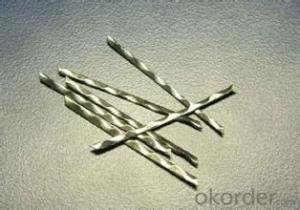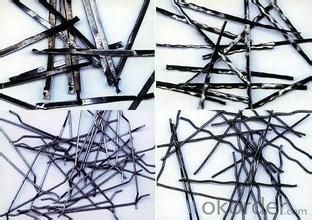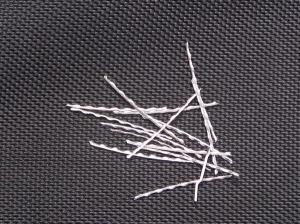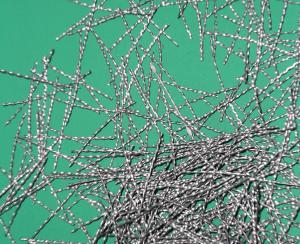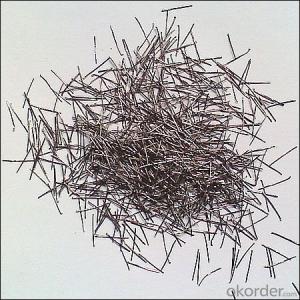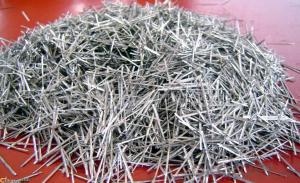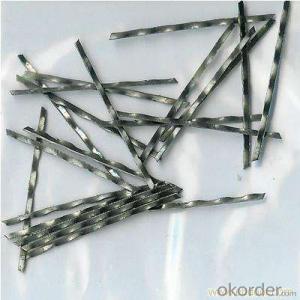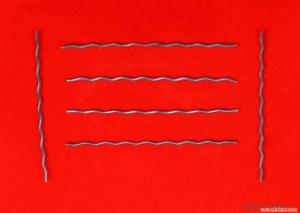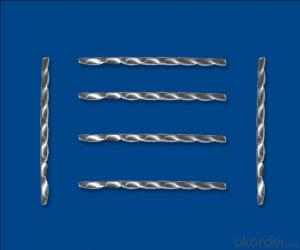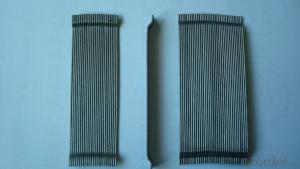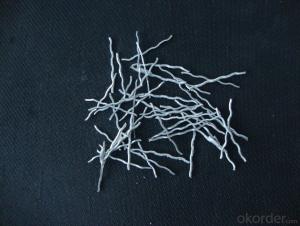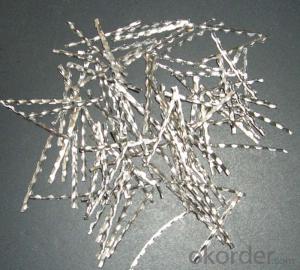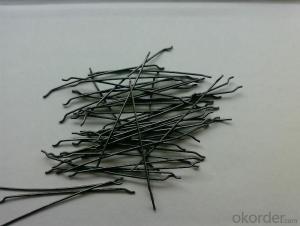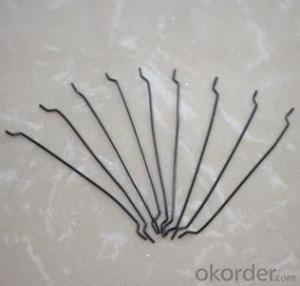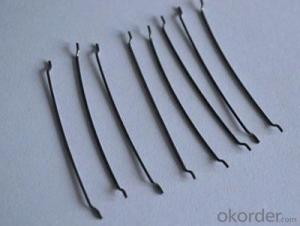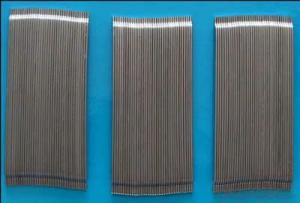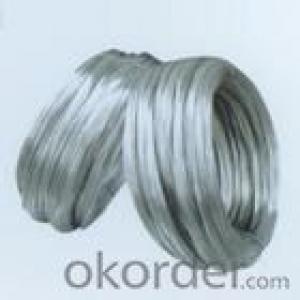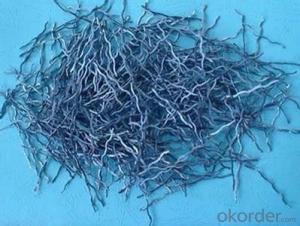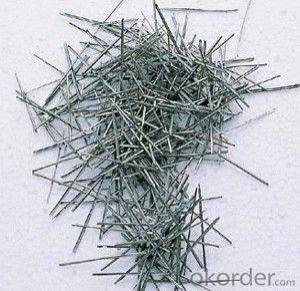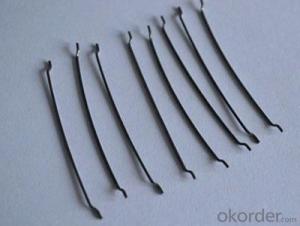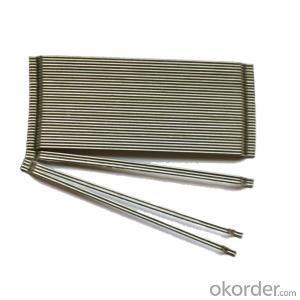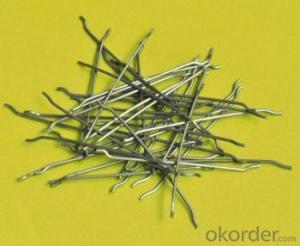Melt Extract Stainless Steel Fiber Reinforced Concrete Admixtures from CNBM International
- Loading Port:
- Tianjin
- Payment Terms:
- TT OR LC
- Min Order Qty:
- 1000 kg
- Supply Capability:
- 250000 kg/month
OKorder Service Pledge
OKorder Financial Service
You Might Also Like
Quick Details
Place of Origin: Shandong, China (Mainland)
Model Number: steel fiber
material: steel wire
application: concrete reinocement
type: end hook steel fiber
Product features
with excellent tensile ,hightenacity ,against cracking and fatigue ,they`re widely usd in the structures made of concrete
Specifications
1.hooked steel fiber
2.CE and ISO9001:2008
3.diameter from 0.5mm to 1.2mm
4.competitive price,high quality and service
Hooked Steel Fiber:
1.Diameter:0.5mm-1.0mm
2.Length: 25mm-60mm
3.Material: low carbon steel wire
4.Feature: excellent tensile,high tenacity,against cracking,impact and fatigue
5.Uses: high way,tunnel,building,airport road serface and so on .
Picture
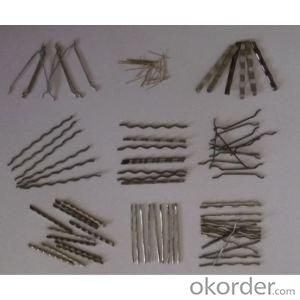
steel fiber concrete reinforced
FAQ
we can produce any type steel fiber and of course we can make production according to your requirement
we have specilize in this field for almost 10 years ,with good quality and competitive price
- Q: How does melt extract stainless steel fiber improve the crack resistance of concrete?
- The crack resistance of concrete is enhanced by melt extract stainless steel fiber in several ways. To begin with, the inclusion of stainless steel fibers in the concrete mix helps to evenly distribute stresses throughout the entire structure. These fibers form a three-dimensional network within the concrete, reinforcing it and preventing cracks from spreading while also improving the efficiency of applied loads. Furthermore, the crack resistance of concrete is improved by the high tensile strength and ductility of stainless steel fibers. These fibers possess exceptional mechanical properties that enable them to absorb and dissipate energy when exposed to external forces or changes in temperature. Consequently, they provide greater resistance to cracking caused by shrinkage, temperature fluctuations, and external loads. Another important factor is the capability of stainless steel fibers to control crack width and limit its propagation. Acting as small bridges across cracks, these fibers reduce their width and prevent them from expanding further. This limitation of crack width ensures the integrity and longevity of the concrete structure. Additionally, stainless steel fibers enhance the flexural strength and toughness of concrete. This increased flexural performance enables the concrete to withstand higher bending stresses and deformations without cracking. Consequently, it enhances the overall crack resistance of the concrete, making it more resistant to initial and subsequent cracking under load. In summary, the addition of melt extract stainless steel fiber significantly improves the crack resistance of concrete by establishing a reinforcing network, absorbing energy, controlling crack width, and enhancing flexural strength and toughness. These combined effects result in a more durable and reliable concrete structure, with reduced cracking and increased resistance to various external factors.
- Q: Can melt extract stainless steel fiber be used in tunnel linings for underground mining?
- Yes, melt extract stainless steel fiber can be used in tunnel linings for underground mining. These fibers are known for their high tensile strength and resistance to corrosion, making them suitable for reinforcing concrete in harsh environments such as mines. Additionally, their superior durability and ability to enhance the structural integrity of tunnel linings make them a reliable choice for underground mining applications.
- Q: How does melt extract stainless steel fiber improve the resistance to sulfate attack in concrete?
- Melt extract stainless steel fiber improves the resistance to sulfate attack in concrete through various mechanisms. Firstly, the addition of stainless steel fibers in the concrete mix enhances the overall durability and longevity of the concrete structure, making it less susceptible to sulfate attack. Sulfate attack occurs when sulfate ions from sources such as groundwater, soil, or industrial waste react with the components of concrete, leading to the formation of expansive compounds that can cause cracking and deterioration of the concrete. The stainless steel fibers, being highly corrosion-resistant, act as a physical barrier against the ingress of sulfate ions into the concrete matrix. They create a network throughout the concrete, providing additional reinforcement and preventing the expansion and cracking caused by sulfate attack. Furthermore, the high tensile strength and flexibility of stainless steel fibers improve the overall mechanical properties of the concrete, making it more resistant to the deleterious effects of sulfate attack. The fibers help to distribute stresses more evenly within the concrete, reducing the potential for cracking and damage. Moreover, the presence of stainless steel fibers can also enhance the resistance of concrete to chemical attack. The stainless steel fibers have a high resistance to corrosion, even in harsh environments, which helps to protect the concrete from the corrosive effects of sulfate ions. In summary, melt extract stainless steel fiber improves the resistance to sulfate attack in concrete by acting as a physical barrier, enhancing the mechanical properties, and providing corrosion resistance. These combined effects result in a more durable and long-lasting concrete structure that can withstand the damaging effects of sulfate attack.
- Q: What is the effect of melt extract stainless steel fiber on the thermal conductivity of concrete?
- The thermal conductivity of concrete can be greatly improved by incorporating melt extract stainless steel fiber. Stainless steel fibers possess excellent thermal conductivity properties, enabling them to effectively transfer heat throughout the concrete. When these fibers are added to the concrete mixture, they create a three-dimensional network that aids in the efficient conduction and distribution of heat. This enhanced thermal conductivity has multiple positive impacts on the performance of the concrete. To begin with, the heightened thermal conductivity can enhance the overall thermal efficiency of structures constructed with this particular type of concrete. It facilitates better heat transfer, leading to more efficient temperature regulation and reducing the need for additional insulation or heating and cooling systems. Furthermore, the improved thermal conductivity can also enhance the durability of the concrete. By evenly distributing heat and minimizing temperature variations, the risk of thermal cracking and damage due to expansion and contraction is diminished. This is particularly advantageous in environments with substantial temperature fluctuations. Moreover, the greater thermal conductivity provided by melt extract stainless steel fiber can also be beneficial in applications like radiant floor heating systems. The fibers effectively transfer heat from the heating elements to the surface, resulting in more efficient and effective heating. In conclusion, the incorporation of melt extract stainless steel fiber in concrete significantly improves its thermal conductivity. This improvement leads to increased thermal efficiency, enhanced durability, and improved performance in various applications where heat transfer is crucial.
- Q: What is the effect of melt extract stainless steel fiber on the abrasion resistance of concrete?
- The addition of melt extract stainless steel fiber to concrete has a significant positive effect on its abrasion resistance. Stainless steel fibers are known for their high tensile strength, corrosion resistance, and durability. When incorporated into concrete, these fibers provide reinforcement and enhance its overall mechanical properties. The melt extract process ensures that the stainless steel fibers are produced with a consistent diameter and length, resulting in improved dispersion throughout the concrete matrix. This even distribution of fibers helps to create a three-dimensional reinforcement network, which effectively increases the concrete's resistance to abrasion. The presence of stainless steel fibers in concrete enhances its ability to withstand wear and tear caused by frictional forces. This is especially beneficial in high traffic areas, such as industrial floors, parking lots, and roadways, where the concrete is subjected to heavy loads, vehicle movement, and continuous foot traffic. Stainless steel fibers also improve the impact resistance of concrete, reducing the likelihood of surface spalling or cracking due to external forces. This added durability leads to reduced maintenance and repair costs over the lifespan of the concrete structure. In summary, the incorporation of melt extract stainless steel fiber in concrete significantly enhances its abrasion resistance. It improves the concrete's ability to withstand wear and tear caused by frictional forces, extends its lifespan, and reduces the need for frequent maintenance and repair.
- Q: How does melt extract stainless steel fiber affect the thermal conductivity of concrete?
- Melt extract stainless steel fiber improves the thermal conductivity of concrete. Due to its high thermal conductivity, the addition of these fibers in the concrete mixture enhances the overall heat transfer capabilities of the material. This leads to improved heat dissipation and reduced temperature gradients within the concrete, making it more efficient in conducting and distributing heat.
- Q: What is the lifespan of melt extract stainless steel fiber in concrete structures?
- The lifespan of melt extract stainless steel fiber in concrete structures can vary due to various factors. Firstly, the quality of the stainless steel fiber used is crucial in determining its durability. High-quality melt extract stainless steel fibers tend to be more resistant to corrosion and can endure harsh environmental conditions, resulting in a longer lifespan. Secondly, the exposure conditions of the concrete structure also influence the longevity of the stainless steel fiber. Concrete structures that face aggressive environments, such as marine or industrial areas with high chloride or chemical content, may undergo accelerated corrosion, leading to a decrease in the lifespan of the stainless steel fiber. Furthermore, the design and construction practices of the concrete structure can impact the performance and long-lasting nature of the stainless steel fiber. Proper installation techniques, which include accurate fiber distribution and embedding, ensure the fiber's optimal performance and durability over time. Generally, if the stainless steel fiber is of excellent quality and the concrete structure is appropriately designed and constructed, melt extract stainless steel fiber can last for 30 to 50 years or even longer. However, it is crucial to regularly inspect and maintain the concrete structure to identify any potential issues or signs of deterioration that may affect the lifespan of the stainless steel fiber.
- Q: Does melt extract stainless steel fiber improve the resistance to chemical attack in concrete?
- Yes, melt extract stainless steel fiber can improve the resistance to chemical attack in concrete. The stainless steel fibers act as a reinforcement within the concrete matrix, enhancing its durability and resistance to chemical substances. This helps prevent deterioration and degradation caused by chemical attacks, thus increasing the lifespan of the concrete structure.
- Q: How does melt extract stainless steel fiber improve the resistance to aging in asphalt mixtures?
- The resistance to aging in asphalt mixtures is improved by melt extract stainless steel fiber in various ways. Firstly, the overall strength and durability of the asphalt mixture are enhanced by adding stainless steel fiber. This increased strength enables the pavement to withstand repetitive loads and traffic stresses, reducing the likelihood of premature cracking, rutting, or other forms of distress. Moreover, stainless steel fiber acts as a reinforcement within the asphalt matrix, preventing crack propagation and reducing aging-related damage. These fibers create a three-dimensional network that distributes stress more evenly throughout the mixture, minimizing stress concentration at specific points and increasing resistance to deformation. Additionally, the presence of stainless steel fiber improves resistance to temperature variations in asphalt mixtures. It helps mitigate the effects of thermal expansion and contraction, reducing the risk of thermal cracking and enhancing long-term pavement performance. Furthermore, stainless steel fiber exhibits excellent corrosion resistance properties. This means that even in harsh environmental conditions, such as moisture or exposure to deicing salts, the fibers will not corrode or degrade over time. This corrosion resistance greatly contributes to improved aging resistance, as it ensures the reinforcing effect of the fibers remains intact throughout the lifespan of the asphalt pavement. In conclusion, melt extract stainless steel fiber enhances resistance to aging in asphalt mixtures by improving overall strength and durability, preventing crack propagation, reducing deformation, mitigating thermal cracking, and providing excellent corrosion resistance. These advantages result in a longer lifespan and improved performance of the asphalt pavement, ultimately saving costs and enhancing the safety and comfort of road users.
- Q: What is the recommended spacing between melt extract stainless steel fibers in concrete?
- The recommended spacing between melt extract stainless steel fibers in concrete typically ranges from 1 inch to 2 inches.
Send your message to us
Melt Extract Stainless Steel Fiber Reinforced Concrete Admixtures from CNBM International
- Loading Port:
- Tianjin
- Payment Terms:
- TT OR LC
- Min Order Qty:
- 1000 kg
- Supply Capability:
- 250000 kg/month
OKorder Service Pledge
OKorder Financial Service
Similar products
Hot products
Hot Searches
Related keywords
